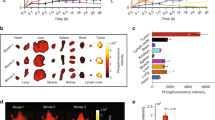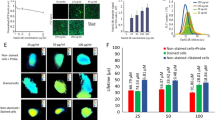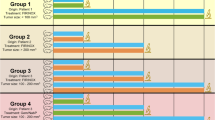Abstract
The partial pressure of oxygen (pO2) and pH play critical roles in tumor biology and therapy. We report here the first combined, high-resolution (≤10 μm) measurements of interstitial pH and pO2 profiles between adjacent vessels in a human tumor xenograft, using fluorescence ratio imaging and phosphorescence quenching microscopy. We found (1) heterogeneity in shapes of pH and pO2 profiles; (2) a discordant relation between local pH profiles and corresponding pO2 profiles, yet a strong correlation between mean pH and pO2 profiles; (3) no correlation between perivascular pH/pO2 and nearest vessel blood flow; and (4) well-perfused tumor vessels that were hypoxic and, consequently, large hypoxic areas in the surrounding interstitium. Such multiparameter measurements of the in vivo microenvironment provide unique insights into biological processes in tumors and their response to treatment.
This is a preview of subscription content, access via your institution
Access options
Subscribe to this journal
Receive 12 print issues and online access
$209.00 per year
only $17.42 per issue
Buy this article
- Purchase on Springer Link
- Instant access to full article PDF
Prices may be subject to local taxes which are calculated during checkout
Similar content being viewed by others
References
Vaupel, P., Kallinowski, F. & Okunieff, P. Blood flow, oxygen and nutrient supply, and metabolic microenvironment of human tumors: A review. Cancer Res. 49, 6449–6465 (1989).
Gullino, P.M., Grantham, F.H., Courtney, A.H. & Losonczy, I. Relationship between oxygen and glucose consumption by transplanted tumors in vivo. Cancer Res. 27, 1041–1052 (1967).
Casciari, J.J., Sotirchos, S.V. & Sutherland, R.M. Variations in tumor Cell growth rates and metabolism with oxygen concentration, glucose concentration, and extraCellular pH. J. Cell. Physiol. 151, 386–394 (1992).
Engin, K. et al. ExtraCellular pH distribution in human tumours. Int. J. Hyperthermia 11, 211–216 (1995).
Shweiki, D., Itin, A., Soffer, D. & Keshet, E. Vascular endothelial growth factor induced by hypoxia may mediate hypoxia-initiated angiogenesis. Nature 359, 843–845 (1992).
Shimizu, S. et al. Induction of apoptosis as well as necrosis by hypoxia and predominant prevention of apoptosis by Bcl-2 and Bcl-XL. Cancer Res. 56, 2161–2166 (1996).
Graeber, T.G. et al. Hypoxia-mediated selection of Cells with diminished apoptotic potential in solid tumours. Nature 379, 88–91 (1996).
Young, P.R. & Spevacek, S.M. Substratum acidification by murine B16F10 melanoma cultures. Biochim. Biophys. Acta 1139, 163–166 (1992).
Turner, G.A. Increased release of tumor Cells by collagenase at acid pH: A possible mechanism for metastasis. Experientia 35, 1657–1658 (1979).
Krtolica, A. & Ludlow, J.W. Hypoxia arrests ovarian carcinoma Cell cycle progression, but invasion is unaffected. Cancer Res. 56, 1168–1173 (1996).
Loeffler, D.A., Juneau, P.L. & Masserant, S. Influence of tumour physico-chemical conditions on interleukin-2-stimulated lymphocyte proliferation. Br. J. Cancer 66, 619–622 (1992).
Suit, H. Tumor oxygenation and radiosensitivity. in Blood Substitutes: Physiological Basis of Efficacy (eds. Winslow, R. M. et al.) 187–199 (Birkhäuser, Boston, 1995).
Wike-Hooley, J.L., Haveman, J. & Rheinhold, H.S. The relevance of tumor pH to the treatment of malignant disease. Radiother. Oncol. 2, 343–366 (1984).
Tannock, I.F. & Rotin, D. Acid pH in tumors and its potential for therapeutic exploitation. Cancer Res. 49, 4373–4384 (1989).
Song, C.W., Lyons, J.C. & Luo, Y. Intra-and extraCellular pH in solid tumors: Influence on therapeutic response. in Drug Resistance in Oncology (ed. Teicher, B.A.) 25–51 (Marcel Dekker, New York, 1993).
Ward, K.A. & Jain, R.K. Response of tumours to hyperglycaemia: Characterization, significance and role in hyperthermia. Int. J. Hyperthermia 4, 223–50 (1988).
Griffiths, J.R. Are cancer Cells acidic? Br. J. Cancer 64, 425–427 (1991).
Jain, R.K., Shah, S.A. & Finney, P.L. Continuous noninvasive monitoring of pH and temperature in rat Walker 256 carcinoma during normoglycemia and hyperglycemia. J. Natl. Cancer Inst. 73, 429–36 (1984).
Gray, L.H., Conger, A.S.D., Ebert, M., Hornsey, S. & Scott, O.C.A. The concentration of oxygen dissolved in tissue at the time of irradiation as a factor in radiotherapy. Br. J. Radial. 26, 638–648 (1953).
Chaplin, D.J. & Acker, B. The effect of hydralazine on the tumor cytotoxicity of the hypoxic Cell cytotoxin RSU 1069: Evidence for therapeutic gain. Int. J. Radial. Oncol. Biol. Phys. 13, 579–586 (1987).
Skarsgard, L.D., Skwarchuk, M.W., Vinczan, A., Kristl, J. & Chaplin, D.J. The cytotoxicity of melphalan and its relationship to pH, hypoxia and drug uptake. Anticancer Res. 15, 219–224 (1995).
Teicher, B.A., Lazo, J.S. & Sartorelli, A.C. Classification of antineoplastic agents by their selective toxicities towards oxygenated and hypoxic tumor Cells. Cancer Res. 41, 73–81 (1981).
Jähde, E. et al. Hydrogen ion-mediated enhancement of cytotoxicity of bischloroethylating drugs in rat mammary carcinoma Cells in vitro. Cancer Res. 49, 2965–2972 (1989).
Karuri, A.R., Dobrowsky, E. & Tannock, I.F. Selective acidification and toxicity of weak organic acids in an acidic microenvironment. Br. J. Cancer 68, 1080–1087 (1993).
Gerweck, L.E. & Seetharaman, K. Cellular pH gradient in tumor versus normal tissue: Potential exploitation for the treatment of cancer. Cancer Res. 56, 1194–1198 (1996).
Hoeckel, M. et al. Intratumoral pO2 predicts survival in advanced cancer of the uterine cervix. Radiother. Oncol. 26, 45–50 (1993).
Engin, K., Leeper, D.B., Thistlethwaite, A.J., Tupchong, L. & McFarlane, J.D. Tumor extraCellular pH as a prognostic factor in thermoradiotherapy. Int. J. Radial. Oncol. Biol. Phys. 29, 125–132 (1994).
Schwickert, G., Walenta, S., Sundf, K., Rofstad, E.K. & Mueller-Klieser, W. Correlation of high lactate levels in human cervical cancer with incidence of metastasis. Cancer Res. 55, 4757–4759 (1995).
Brizel, D.M. et al. Tumor oxygenation predicts for the likelihood of distant metastases in human soft tissue sarcoma. Cancer Res. 56, 941–943 (1996).
Vaupel, P.W., Frinak, S. & Bicher, H.I. Heterogeneous oxygen partial pressure and pH distribution in C3H mouse mammary adenocarcinoma. Cancer Res. 41, 2008–2013 (1981).
Daly, P.F. & Cohen, J.S. Magnetic resonance spectroscopy of tumors and potential in vivo clinical applications: A review. Cancer Res. 49, 770–779 (1989).
Hawkins, R.A. & Phelps, M.E. PET in clinical oncology. Cancer Metastasis Rev. 7, 119–142 (1988).
Evans, S.M., Jenkins, W.T., Joiner, B., Lord, E.M. & Koch, C.J., 2-Nitroimidazole (EF5) binding predicts radiation resistance in individual 9L s. c. tumors. Cancer Res. 56, 405–411 (1996).
Gullino, P.M., Clark, S.H. & Grantham, F.H. The interstitial fluid of solid tumors. Cancer Res. 24, 780–797 (1964).
Jain, R.K. Delivery of molecular medicine to solid tumors. Science 271, 1079–1080 (1996).
Warburg, O. The Metabolism of Tumors (R.R. Smith, New York, 1931).
Acker, H., Carlsson, J., Holtermann, G., Nederman, T. & Nylén, T. Influence of glucose and buffer capacity in the culture medium on growth and pH in spheroids of human thyroid carcinoma and human glioma origin. Cancer Res. 47, 3504–3508 (1987).
Sutherland, R.M. et al. Oxygenation and differentiation in multiCellular spheroids of human colon carcinoma. Cancer Res. 46, 5320–5329 (1986).
Casciari, J.J., Sotirchos, S.V. & Sutherland, R.M. Glucose diffusivity in multiCellular tumor spheroids. Cancer Res. 48, 3905–3909 (1988).
Dewhirst, M.W. et al. Perivascular oxygen tensions in a transplantable mammary tumor growing in a dorsal flap window chamber. Radiat. Res. 130, 171–182 (1992).
Torres-Filho, I.P., Leunig, M., Yuan, F., Intaglietta, M. & Jain, R.K. Noninvasive measurement of microvascular and interstitial oxygen profiles in a human tumor in SCID mice. Proc. Natl. Acad. Sci. USA 91, 2081–5 (1994).
Martin, G.R. & Jain, R.K., Noninvasive measurement of interstitial pH profiles in normal and neoplastic tissue using fluorescence ratio imaging microscopy. Cancer Res. 54, 5670–5674 (1994).
Dellian, M., Helmlinger, G., Yuan, F. & Jain, R.K. Interstitial pH in solid tumours measured by fluorescence ratio imaging and optical sectioning: Effect of glucose on spatial and temporal gradients. Br. J. Cancer 74, 1206–1215 (1996).
Leunig, M. et al. Angiogenesis, microvascular architecture, microhemodynamics, and interstitial fluid pressure during early growth of human adenocarcinoma LS174T in SCID mice. Cancer Res. 52, 6553–60 (1992).
Torres Filho, I.P. & Intaglietta, M. Microvessel pO2, measurements by phosphorescence decay method. Am. J. Physiol. 265, H1434–H1438 (1993).
Vanderkooi, J.M., Maniara, G., Green, T.J. & Wilson, D.F. An optical method for measurement of dioxygen concentration based upon quenching of phosphorescence. J. Biol. Chem. 262, 5476–5482 (1987).
Zheng, L., Golub, A.S. & Pittman, R.N. Determination of pO2, and its heterogeneity in single capillaries. Am. J. Physiol. 271, H365–H372 (1996).
Author information
Authors and Affiliations
Rights and permissions
About this article
Cite this article
Helmlinger, G., Yuan, F., Dellian, M. et al. Interstitial pH and pO2 gradients in solid tumors in vivo: High-resolution measurements reveal a lack of correlation. Nat Med 3, 177–182 (1997). https://doi.org/10.1038/nm0297-177
Received:
Accepted:
Issue Date:
DOI: https://doi.org/10.1038/nm0297-177
This article is cited by
-
EGLN3 attenuates gastric cancer cell malignant characteristics by inhibiting JMJD8/NF-κB signalling activation independent of hydroxylase activity
British Journal of Cancer (2024)
-
pH-regulated single cell migration
Pflügers Archiv - European Journal of Physiology (2024)
-
Acid-sensing ion channels and downstream signalling in cancer cells: is there a mechanistic link?
Pflügers Archiv - European Journal of Physiology (2024)
-
Glycerol-weighted chemical exchange saturation transfer nanoprobes allow 19F/1H dual-modality magnetic resonance imaging-guided cancer radiotherapy
Nature Communications (2023)
-
Intravital imaging to study cancer progression and metastasis
Nature Reviews Cancer (2023)



